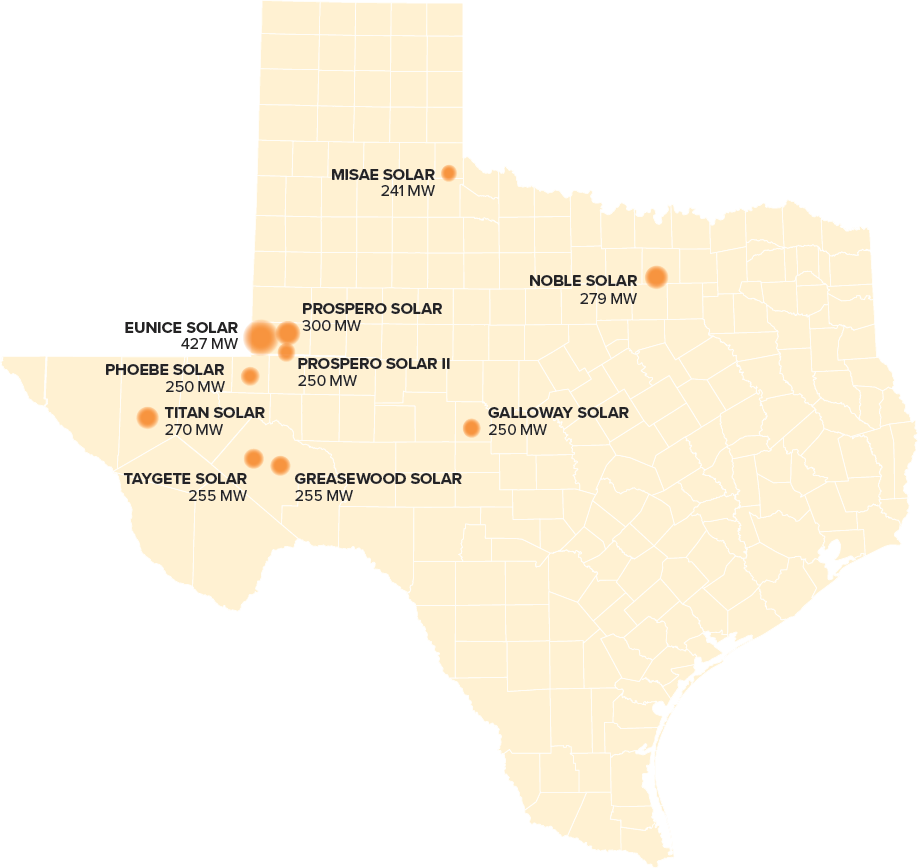Energy is Good for Texas
Solar energy is an important part of Texas’ energy portfolio, contributing 6 percent of the state’s energy generation in 2022. With an abundance of sunny days, Texas has become a leading state for the greatest energy potential and generation from solar power.
Solar energy converts power from the sun into thermal or electrical energy. The two most commonly used types of solar energy generating technologies are photovoltaics (PV) and concentrating solar thermal power (CSP).
Solar
Texas’ solar capacity has grown substantially with the construction of new large solar farms and solar installations.
Solar Energy in Texas
In 2021, the cumulative capacity of CSP and PV energy generation totaled 15 million megawatt (MWh) hours.

Texas ranks first in the nation in projected growth in solar energy with more than 40,000 megawatts (MW) of added solar capacity projected over the next five years.
According to the Public Utility Commission of Texas, nearly 9,500 solar-powered, electric-generating projects in Texas have been completed since 1995 and nearly 23,700 projects have been announced during the same period.
Solar Energy Economics in Texas
Solar Electric Power Generation Jobs, 2022
14,830
Average Annual Wage for Solar Electric Power Generation Jobs, 2022
$109,554
Gross Domestic Product, 2021
$877.8 million
Largest Solar Electric Generating Plants
in Texas by Capacity, 2023
View Map Details
| Facility | County | Capacity (MW) | In Service |
|---|---|---|---|
| Eunice Solar | Andrews | 427 | Sept. 2021 |
| Prospero Solar | Andrews | 300 | Jun. 2020 |
| Noble Solar | Denton | 279 | Sept. 2022 |
| Titan Solar | Culberson | 270 | Nov. 2021 |
| Taygete Solar | Pecos | 255 | Jun. 2021 |
| Greasewood Solar | Pecos | 255 | Feb. 2021 |
| Phoebe Solar | Winkler | 250 | Nov. 2019 |
| Prospero Solar II | Andrews | 250 | Sept. 2021 |
| Galloway Solar | Concho | 250 | Oct. 2021 |
| Misae Solar | Childress | 241 | Dec. 2021 |

Outlook
One disadvantage of solar energy is that this form of energy is weather dependent and cannot be collected during cloudy or rainy days. Additionally, while the cost of solar technology has declined 43 percent over the last 10 years, utility-scale solar plants often require large plots: anywhere between five to 10 acres per megawatt of generating capacity.
Despite these obstacles, solar energy is still the leading source of new generating capacity in the United States and is expected to continue growing. By 2035, wind and solar generation combined are expected in to double in Texas.
Thanks to the rapid growth of solar power research and technology, the energy source has become a valuable part of the Texas energy network.
Source: Public Utility Commission of Texas
This is one in a series of reports the Comptroller has prepared on energy in Texas.
See more information on energy Issues and the Texas economy.
Questions?
If you have any questions or concerns regarding the material on this page, please contact the Comptroller’s Data Analysis and Transparency Division.
